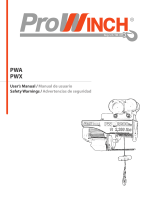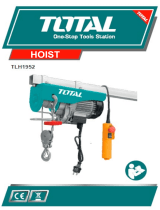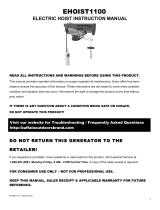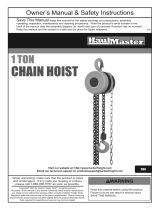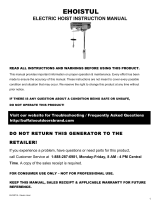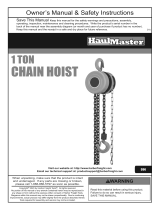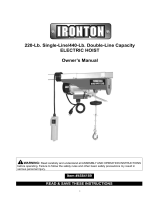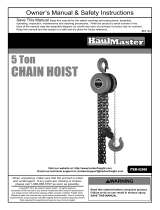Page is loading ...

!"#"$%&'(%)*+#"$*%,$-%.$$/-00)))1.,(+&(2(*"3.$14&5
65,"7%&'(%$*4.8"4,7%#'//&($%,$-%/(&9'4$#'//&($:.,(+&(2(*"3.$14&5
Owner’s Manual & Safety Instructions
Save This Manual Keep this manual for the safety warnings and precautions, assembly,
operating, inspection, maintenance and cleaning procedures. Write the product’s serial number in the
back of the manual near the assembly diagram (or month and year of purchase if product has no number).
Keep this manual and the receipt in a safe and dry place for future reference. 21d
When unpacking, make sure that the product is intact
and undamaged. If any parts are missing or broken,
please call 1-888-866-5797 as soon as possible.
Copyright
©
2020 by Harbor Freight Tools
®
. All rights reserved.
No portion of this manual or any artwork contained herein may be reproduced in
any shape or form without the express written consent of Harbor Freight Tools.
Diagrams within this manual may not be drawn proportionally. Due to continuing
improvements, actual product may differ slightly from the product described herein.
Tools required for assembly an d se rv ic e may n ot b e in cl uded.
Read this material before using this product.
Failure to do so can result in serious injury.
SAVE THIS MANUAL.

Page 2 ;&(%$*4.8"4,7%<'*#$"&8#=%/7*,#*%4,77%>?@@@?@AA?BCDC1 Item 60346
EF;6GH IJ6KFGLIM LMEJ6NGLIMLMEGFOOFGLIM
G,+7*%&2%N&8$*8$#
Safety ......................................................... 2
Specifications ............................................. 5
Installation .................................................. 5
Operation .................................................... 6
Inspection ................................................... 8
Parts List and Diagram .............................. 10
Warranty .................................................... 12
PFKMLMQ%EHRSIOE%FMT%T6;LMLGLIME
This is the safety alert symbol. It is used to alert you to potential
personal injury hazards. Obey all safety messages that
follow this symbol to avoid possible injury or death.
Indicates a hazardous situation which, if not avoided,
will result in death or serious injury.
Indicates a hazardous situation which, if not avoided,
could result in death or serious injury.
Indicates a hazardous situation which, if not avoided,
could result in minor or moderate injury.
Addresses practices not related to personal injury.
LRJIKGFMG%EF;6GH%LM;IKRFGLIM
GI%JK6!6MG%E6KLIUE%LMVUKH%FMT%T6FGW-
S,#"4%E,2*$X%L82&(5,$"&8
1. G&%K*9'4*%$.*%K"#Y%&2%67*4$("4%E.&4Y%&(%L8Z'(X=%%
U#*%L89&&(#%I87X1
2. T&%8&$%7"2$%5&(*%$.,8%(,$*9%7&,91%%S*%,),(*%&2%
9X8,5"4%7&,9"83[ Sudden load movement may
briefly create excess load causing product failure.
3. T&%8&$%&/*(,$*%).*8%7&,9%"#%8&$%
4*8$*(*9%'89*(8*,$.1
4. T&%8&$%&/*(,$*%.&"#$%)"$.%$)"#$*9=%Y"8Y*9=%&(%
9,5,3*9%)"(*%(&/*1%%%
Inspect wire rope carefully before every use.
5. T&%8&$%&/*(,$*%,%9,5,3*9%&(%
5,72'84$"&8"83%.&"#$1%%Inspect hoist carefully
and test operation before every use.
6. T&%8&$%7"2$%/*&/7*%&(%7"2$%7&,9#%&\*(%/*&/7*1
Falling loads can injure or kill people.
Do not use as elevator.
7. T&%8&$%&/*(,$*%)"$.%(&/*%8&$%
4*8$*(*9%"8%"$#%3(&&\*1
8. T&%8&$%(*5&\*%&(%4&\*(%),(8"83%7,+*7#%,890
&(%$,3#1%%These carry important safety information.
If unreadable or missing, contact
Harbor Freight Tools for a replacement.
9. Do not lift animals or use for aircraft purposes.
10. The warnings, precautions, and instructions
discussed in this instruction manual cannot
cover all possible conditions and situations
that may occur. It must be understood by the
operator that common sense and caution are
factors which cannot be built into this product,
but must be supplied by the operator.

Page 3;&(%$*4.8"4,7%<'*#$"&8#=%/7*,#*%4,77%>?@@@?@AA?BCDC1Item 60346
EF;6GHIJ6KFGLIMLMEJ6NGLIM LMEGFOOFGLIM
L8#$,77,$"&8%E/*4"2"4%E,2*$X%L82&(5,$"&8
1. The supporting structure the hoist is mounted
to (including trolley, monorail, or crane) must
be designed to withstand the loads and forces
imposed by the hoist for the rated load.
2. Install in location that allows the operator
to move and stay clear of the load.
3. Locate pendant controls at a convenient
level above the operating floor.
4. Do not install where the load hook can
be lowered beyond the rated hook travel
under normal operating conditions.
G,+7*%F-%%K6NIRR6MT6T%RLMLRUR%PLK6%QFUQ6%
;IK%6]G6MELIM%NIKTE%
^>_`%!IOGa
MFR6JOFG6%
FRJ6K6E
^,$%2'77%7&,9a
6]G6MELIM%NIKT%
O6MQGW
0 – 6 18 16 16 14
6.1 – 10 18 16 14 12
10.1 – 12 16 16 14 12
12.1 – 16 14 12 T&%8&$%'#*1
5. USE PROPER EXTENSION CORD.
Make sure your extension cord is in good condition.
When using an extension cord, be sure to
use one heavy enough to carry the current
your product will draw. An undersized cord will
cause a drop in line voltage resulting in loss
of power and overheating. %Table A shows the
correct size to use depending on cord length
and nameplate ampere rating. If in doubt, use
the next heavier gauge. The smaller the
gauge number, the heavier the cord.
6. Inspect the hoist as explained in Frequent Inspection
on page 8 after installation but before use.
L8#/*4$"&8=%G*#$"83=%,89%R,"8$*8,84*%E/*4"2"4%E,2*$X%L82&(5,$"&8
1. Perform a “Frequent Inspection”
at least monthly, see page 8.
2. Perform a “Periodic (Thorough) Inspection”
at least yearly, see page 8.
3. More frequent inspections are needed
for hoists that are used heavily.
4. Raise test loads only to the minimum extent needed
and stay well clear of load at all times during testing.
I/*(,$"&8%E/*4"2"4%E,2*$X%L82&(5,$"&8
1. Wear ANSI-approved safety goggles,
ANSI-approved hard hat, and
steel-toed work boots during setup and use.
2. This product is not a toy.
Do not allow children to play with or near this item.
3. Use as intended only.
• Do not use to handle molten material.
• Do not use for aircraft purposes.
• Do not use to link towed vehicles.
4. Keep hands clear of moving parts.
5. People with pacemakers should consult their
physician(s) before use. Electromagnetic fields in
close proximity to heart pacemaker could cause
pacemaker interference or pacemaker failure. In
addition, people with pacemakers should:
• Avoid operating alone.
• Properly maintain and inspect to avoid
electrical shock.
• Properly ground power cord. Ground Fault Circuit
Interrupter (GFCI) should also be implemented
– it prevents sustained electrical shock.
%EF!6%GW6E6%LMEGKUNGLIME1

Page 4 ;&(%$*4.8"4,7%<'*#$"&8#=%/7*,#*%4,77%>?@@@?@AA?BCDC1 Item 60346
EF;6GH IJ6KFGLIM LMEJ6NGLIMLMEGFOOFGLIM
Q(&'89"83%L8#$('4$"&8#
%
GI%JK6!6MG%6O6NGKLN%EWINb%FMT%T6FGW%;KIR%LMNIKK6NG%QKIUMTLMQ%PLK6%
NIMM6NGLIM%
K6FT%FMT%;IOOIP%GW6E6%LMEGKUNGLIME-
1. In the event of a malfunction or breakdown,
grounding provides a path of least resistance for
electric current to reduce the risk of electric shock.
This hoist is equipped with an electric cord having
an equipment-grounding conductor and a grounding
plug. The plug must be plugged into a matching
outlet that is properly installed and grounded in
accordance with all local codes and ordinances.
2. Do not modify the plug provided – if it will
not fit the outlet, have the proper outlet
installed by a qualified electrician.
3. Improper connection of the equipment-grounding
conductor can result in a risk of electric shock.
The conductor with insulation having an outer
surface that is green with or without yellow
stripes is the equipment-grounding conductor.
If repair or replacement of the electric cord or
plug is necessary, do not connect the equipment-
grounding conductor to a live terminal.
4. Check with a qualified electrician or service
personnel if the grounding instructions are
not completely understood, or if in doubt as
to whether the hoist is properly grounded.
5. Use only 3-wire extension cords that
have 3-prong grounding plugs and 3-pole
receptacles that accept the hoist’s plug.
6. Repair or replace damaged or
worn cord immediately.
>_B%!FN%c?J(&83%J7'3%,89%I'$7*$
^2&(%'/%$&%>_B%!FN%,89%'/%$&%>B%Fa
Q(&'89"83%
J"8
7. This hoist is intended for use on a circuit that has
an outlet that looks like the one illustrated above in
>_B%!FN%c?J(&83%J7'3%,89%I'$7*$. The hoist has
a grounding plug that looks like the plug illustrated
above in >_B%!FN%c?J(&83%J7'3%,89%I'$7*$.
8. The outlet must be properly installed and grounded
in accordance with all codes and ordinances.
9. Do not use an adapter to connect
this hoist to a different outlet.

Page 5;&(%$*4.8"4,7%<'*#$"&8#=%/7*,#*%4,77%>?@@@?@AA?BCDC1Item 60346
EF;6GHIJ6KFGLIMLMEJ6NGLIM LMEGFOOFGLIM
E/*4"2"4,$"&8#
Electrical Rating 120VAC / 60Hz / 4.5A
Rated Capacity
440 lb. double line
220 lb. single line
Lifting Speed 26 FPM (single); 13 FPM (double)
Cable Length 39'
Cable Diameter 0.12" (3mm)
Duty Cycle 20%*
*This Hoist has a 20% duty cycle. This means that the Hoist may only be run up to 2 minutes at a time
and then it must be allowed to rest for at least 8 minutes before further use.
L8#$,77,$"&8%L8#$('4$"&8#
%K*,9%$.*%6MGLK6%LRJIKGFMG%EF;6GH%LM;IKRFGLIM%#*4$"&8%,$%$.*%+*3"88"83%&2%$."#%
5,8',7%"847'9"83%,77%$*d$%'89*(%#'+.*,9"83#%$.*(*"8%+*2&(*%#*$%'/%&(%'#*%&2%$."#%/(&9'4$1
M&$*- For additional information regarding the parts listed in the
following pages, refer to Parts List and Diagram on page 10.
1. The supporting structure the hoist is mounted to
(including trolley, monorail, or crane)
must be designed to withstand the loads and
forces imposed by the hoist for the rated load.
2. Place the two Hanging Clamps over the supporting
structure where the hoist will be mounted.
3. Have an assistant hold the Hoist in place and attach
the Hanging Clamps to the Housing using the
Bolts, Lock Washers, Washers and Nuts supplied.
4. Once the Hoist is in position, tighten Nuts firmly.

Page 6 ;&(%$*4.8"4,7%<'*#$"&8#=%/7*,#*%4,77%>?@@@?@AA?BCDC1 Item 60346
EF;6GH IJ6KFGLIM LMEJ6NGLIMLMEGFOOFGLIM
I/*(,$"&8%L8#$('4$"&8#
%K*,9%$.*%6MGLK6%LRJIKGFMG%EF;6GH%LM;IKRFGLIM%#*4$"&8%,$%$.*%+*3"88"83%&2%$."#%
5,8',7%"847'9"83%,77%$*d$%'89*(%#'+.*,9"83#%$.*(*"8%+*2&(*%#*$%'/%&(%'#*%&2%$."#%/(&9'4$1
GI%JK6!6MG%E6KLIUE%LMVUKH-%%I/*(,$"&8%&2%,%\*($"4,7%.&"#$%"8\&7\*#%5&(*%$.,8%9*/(*##"83%
$.*%UJ%&(%TIPM%4&8$(&71%%G.*%'#*%&2%\*($"4,7%.&"#$#%"#%#'+Z*4$%$&%4*($,"8%.,e,(9#%$.,$%4,88&$%+*%
5*$%+X%5*4.,8"4,7%5*,8#=%+'$%&87X%+X%$.*%*d*(4"#*%&2%"8$*77"3*84*=%4,(*=%4&55&8%#*8#*=%,89%
*d/*("*84*%"8%,8$"4"/,$"83%$.*%5&$"&8#%$.,$%)"77%&44'(%,#%,%(*#'7$%&2%&/*(,$"83%$.*%4&8$(&7#1
S*2&(*%I/*(,$"83%W&"#$
1. Familiarize yourself with all operating controls
of the hoist and with the operation(s) to be
performed. Instructions include, the warnings
on the hoist, and the safety and operating
instructions portion of this manual.
2. PFKMLMQ[%%GI%JK6!6MG%E6KLIUE%LMVUKH%
;KIR%WILEG%;FLOUK6-%
T&%8&$%'#*%9,5,3*9%*<'"/5*8$1%%%
L2%,9Z'#$5*8$#%&(%(*/,"(#%,(*%8*4*##,(X=%
&(%,8X%9*2*4$#%,(*%Y8&)8=%%.,\*%$.*%
/(&+7*5%4&((*4$*9%+*2&(*%2'($.*(%'#*1
3. Do not operate a hoist with an out-of-order sign.
4. Only a qualified technician should
perform maintenance to the hoist.
5. Do not use the wire rope as a ground for welding.
Do not touch a welding electrode to the wire rope.
6. Designate a work area that is clean and well-lit.
The work area must not allow access by children
or pets to prevent distraction and injury.
7. Route the power cord along a safe route to reach
the work area without creating a tripping hazard or
exposing the power cord to possible damage. The
power cord must reach the work area with enough
extra length to allow free movement while working.
8. There must not be objects, such as utility lines,
nearby that will present a hazard while working.
9. Inspect the hoist as explained in Frequent Inspection
on page 8 after installation but before use.
I/*(,$"83%N&8$(&7#
N&8$(&77*(
E$&/%
S(,4Y*$
J'77*X%
W&&Y
689%W&&Y
K*$(,4$%N,+7*%%
^(,"#*%.&&Ya
6d$*89%N,+7*%
^7&)*(%.&&Ya
_`f%T'$X%NX47*%
_%5"8'$*#%"8%'#*%
2&77&)*9%+X%
,$%7*,#$%@%5"8'$*#%&22
This Hoist has a 20% duty cycle.
This means that the Hoist may only be run up to
2 minutes at a time and then it must be allowed to
rest for at least 8 minutes before further use.

Page 7;&(%$*4.8"4,7%<'*#$"&8#=%/7*,#*%4,77%>?@@@?@AA?BCDC1Item 60346
EF;6GHIJ6KFGLIMLMEJ6NGLIM LMEGFOOFGLIM
F//7X"83%$.*%O&,9
1. Do not wrap the hoist wire rope around the load.
2. Attach the load to the load hook securely by
properly rated, suitable means, such as chains,
shackles, hooks, lifting slings, etc. Load must be
attached to prevent accidental disconnection.
;"3'(*%F-%%N&((*4$%,89%"84&((*4$%
7&,9%.&&Y%,$$,4.5*8$
3. Properly seat the sling or other device
in the base (bowl or saddle) of the hook
(see the left side diagram on Figure A). Do not
allow the hook hitch to support any part of the load.
4. Do not apply the load to the point of the hook
(shown in Figure A on the right side diagram).
5. Before moving the load, make sure wire rope is
not kinked or twisted or that multiple part wire
ropes are not twisted around each other.
6. Do not operate the hoist unless wire rope is seated
properly on the drum, pulleys, or sprockets.
7. Do not operate the hoist unless the hoist
unit is centered over the load.
8. Do not pick up a load in excess of the rated
load appearing on the hoist or load block,
except during properly authorized tests.
Do not use a hoist overload limiting device to
measure the maximum load to be lifted.
9. Give specific attention to load balancing and
hitching or slinging to prevent load slipping.
R&\"83%$.*%O&,9
1. Do not engage in any activity which will divert the
operator’s attention while operating the hoist.
2. Respond to signals from a designated person only.
However, always obey a stop signal,
no matter who gives it.
3. Do not lift or lower a load with the
hoist until the operator and all other
personnel are clear of the load.
4. Make sure the load and hoist will clear all
obstacles before moving or rotating the load.
5. Inch hoists slowly into engagement with a load,
but avoid unnecessarily inching and
quick reversals of direction.
6. Do not lift a load more than a few inches until it
is well balanced in the sling or lifting device.
7. Each time a load approaching rated capacity is
handled, check hoist brake action by lifting the
load just clear of supports and continuing only after
verifying that the brake system is operating properly.
8. Do not lower the load below the point where less
than two wraps of rope remain on each anchorage
of the hoist drum, unless a lower limit device is
provided, in which case no less than one wrap may
remain on each anchorage of the hoist drum.
9. PFKMLMQ[%T&%8&$%4,((X%,8X%
7&,9%&\*(%,8X%/*(#&81
10. PFKMLMQ[%%GI%JK6!6MG%E6KLIUE%LMVUKH-%T&%
8&$%4,((X%/*(#&88*7%&8%$.*%.&&Y%&(%$.*%7&,91
11. Avoid swinging the load or load hook
when traveling the hoist.
12. On trolley mounted hoists, avoid contact between
trolleys and between trolleys and stops.
13. Do not use the upper limit device as
a normal means of stopping the hoist.
These are emergency devices only.
J,(Y"83%$.*%O&,9
1. Do not leave a suspended load unattended
unless specific precautions have been
instituted and are in place.
2. Position the load block above head level
for storage when the hoist is not in use.
3. Exercise care when removing a sling from
under a landed and blocked load.

Page 8 ;&(%$*4.8"4,7%<'*#$"&8#=%/7*,#*%4,77%>?@@@?@AA?BCDC1 Item 60346
EF;6GH IJ6KFGLIM LMEJ6NGLIMLMEGFOOFGLIM
L8#/*4$"&8=%G*#$"83=%,89%R,"8$*8,84*
%J(&4*9'(*#%8&$%#/*4"2"4,77X%*d/7,"8*9%"8%$."#%5,8',7%5'#$%
+*%/*(2&(5*9%&87X%+X%,%<',7"2"*9%$*4.8"4",81
GI%JK6!6MG%E6KLIUE%LMVUKH%;KIR%
FNNLT6MGFO%IJ6KFGLIM-%
K*5&\*%,8X%7&,9=%(*7*,#*%$.*%&/*(,$"83%4&8$(&7#=%
,89%9*$,4.%$.*%/&)*(%4&(9%+*2&(*%/*(2&(5"83%,8X%
"8#/*4$"&8=%5,"8$*8,84*=%&(%47*,8"83%/(&4*9'(*#1
GI%JK6!6MG%E6KLIUE%LMVUKH%;KIR%GIIO%
;FLOUK6-%%T&%8&$%'#*%9,5,3*9%*<'"/5*8$1%%
L2%,+8&(5,7%8&"#*%&(%\"+(,$"&8%&44'(#=%.,\*%
$.*%/(&+7*5%4&((*4$*9%+*2&(*%2'($.*(%'#*1
;(*<'*8$%L8#/*4$"&8
J*(2&(5%$.*%/(&4*9'(*#%"8%$."#%#*4$"&8%S6;IK6%
LMLGLFO%UE6%,89%FG%O6FEG%RIMGWOH1%%L8#/*4$"&8%
"#%8**9*9%5&(*%&2$*8%2&(%.*,\"7X%'#*9%.&"#$#1
1. Check operating mechanisms for proper operation,
proper adjustment, and unusual sounds
such as, but not limited to, binding noise
of the wire rope and bearing squeal.
2. Check hoist upper limit device without a load on the
hook at the beginning of each shift. Exercise care.
Run the load block into its limit device at slow speed.
3. Frequent Braking System Inspection
a. The braking system must automatically
stop and hold up to the rated load if the
operating controls are released and in
the event of complete power failure.
b. Braking systems must limit the speed of
load during lowering, with or without power,
to prevent uncontrolled or rapid lowering.
4. Frequent Hook Inspection
Check hooks for the following problems:
a. distortion, such as bending, twisting,
or increased throat opening;
b. wear;
c. cracks, nicks, or gouges;
d. latch engagement (if equipped);
e. damaged or malfunctioning latch (if equipped);
f. hook attachment and securing means.
5. Frequent Hoist Rope Inspection
All ropes should be visually inspected by
the operator or other designated person at the
start of each shift. These visual observations should
be concerned with discovering gross damage, such
as listed below,
which may be an immediate hazard:
a. distortion of the rope such as kinking,
crushing, unstranding, birdcaging,
main strand displacement, or core protrusion;
b. general corrosion;
c. broken or cut strands;
d. number, distribution, and type
of visible broken wires:
1) in running ropes,
12 randomly distributed broken wires in one lay
or four broken wires in one strand in one lay;
2) one outer wire broken at the contact point
with the core of the rope which has worked its
way out of the rope structure and protrudes
or loops out from the rope structure.
If such damage is discovered, either remove
the rope from service or arrange for a qualified
technician to give it a periodic (thorough) inspection.
6. Check wire rope reeving.
PFKMLMQ[%%GI%JK6!6MG%E6KLIUE%LMVUKH%;KIR%WILEG%;FLOUK6-%%T&%8&$%'#*%9,5,3*9%*<'"/5*8$1%%%
L2%,8X%9*2*4$%&(%9,5,3*%"#%8&$*9=%.,\*%$.*%/(&+7*5%4&((*4$*9%+*2&(*%2'($.*(%'#*1
J*("&9"4%^G.&(&'3.a%L8#/*4$"&8
F%<',7"2"*9%$*4.8"4",8%#.&'79%/*(2&(5%
$.*%/(&4*9'(*#%"8%$."#%#*4$"&8%
FG%O6FEG%H6FKOH1%%L8#/*4$"&8%"#%8**9*9%
5&(*%&2$*8%2&(%.*,\"7X%'#*9%.&"#$#1
Remove or open access covers to
allow inspection of components.
1. First, follow all Frequent Inspection procedures.
Additionally:
2. Check fasteners for evidence of loosening.
3. Check load blocks, suspension housings, clevises,
yokes, suspension bolts, shafts, gears, bearings,
pins, rollers, and locking and clamping devices for
evidence of wear, corrosion, cracks, and distortion.
4. Check hook retaining nuts or collars, and
pins, welds, or rivets used to secure the
retaining members for evidence of damage.
5. Check load sprockets, idler sprockets, drums,
and pulleys for evidence of damage and wear.
6. Check the motor brake and load brake
for evidence of wear.

Page 9;&(%$*4.8"4,7%<'*#$"&8#=%/7*,#*%4,77%>?@@@?@AA?BCDC1Item 60346
EF;6GHIJ6KFGLIMLMEJ6NGLIM LMEGFOOFGLIM
7. Check electrical apparatus for evidence of
pitting or deterioration of controller contacts.
8. Check supporting structure or trolley,
if used, for evidence of damage.
9. Check warning label for legibility and replacement.
10. Check end connections of wire ropes for evidence
of wear, corrosion, cracks, damage, and distortion.
11. Periodic (Thorough) Hoist Rope Inspection
Check entire length of rope hoist rope as follows:
Inspect the individual outer wires in the strands
of the rope. Keep a record of any deterioration
resulting in appreciable loss of original strength,
such as described below, and have a qualified
technician determine whether further use
of the rope would constitute a hazard:
a. Check points listed in Frequent
Hoist Rope Inspection on page 8.
b. Check for reduction of rope diameter
below nominal diameter due to loss of
core support, internal or external corrosion,
or wear of outside wires.
c. Check for severely corroded or broken
wires at end connections.
d. Check for severely corroded, cracked, bent,
worn, or improperly applied end connections.
e. Inspect with special care the following
sections of rapid deterioration:
1) sections in contact with saddles,
equalizer pulleys, or other pulleys
where rope travel is limited;
2) sections of the rope at or near terminal ends
where corroded or broken wires may protrude;
3) sections subject to reverse bends;
4) sections of rope which are normally
hidden during visual inspection, such
as parts passing over pulleys.
12. Check function labels on pendant
control(s) for legibility.
13. Check the hoist and hoist mounting
for evidence of missing parts.
PFKMLMQ[%%GI%JK6!6MG%E6KLIUE%LMVUKH%;KIR%WILEG%;FLOUK6-%%T&%8&$%'#*%9,5,3*9%*<'"/5*8$1%%%
L2%,8X%9*2*4$%&(%9,5,3*%"#%8&$*9=%.,\*%$.*%/(&+7*5%4&((*4$*9%+*2&(*%2'($.*(%'#*1
E$&(,3*%L8#/*4$"&8
1. A hoist that has been idle for a period of
a month or more, but less than a year,
must be inspected before being used according
to the Frequent Inspection requirements.
2. A hoist that has been idle for a period of a
year or more, must be inspected according
to the Periodic Inspection requirements and
then tested according to the procedure in the
Testing section below before being used.
R,"8$*8,84*
1. Repair or replacement of hoist components must be
performed only by a qualified technician using only
identical replacement parts with the same rating.
2. Operating mechanisms, limit switches, control
systems, and brakes may require adjustment.
3. Note the following regarding specific components:
a. Replace damaged or worn hooks.
Do not repair them by welding or reshaping.
b. Replace or repair all critical parts
that are cracked, broken, bent,
excessively worn, or missing.
c. Replace missing or illegible warning labels.
d. Replace pitted or burned
electrical contacts as complete sets.
e. Keep controller function labels on pendant
control stations and master switches legible.
4. Do not repair load-sustaining members by welding.
Replace them as needed.
5. Lubricate all moving parts regularly using grease.
6. After maintenance work is completed and before
restoring the hoist to normal operation:
a. reinstall guards;
b. reactivate safety devices;
c. remove replaced parts and loose material;
d. remove maintenance equipment.
G*#$"83
1. Before use, test repaired hoists and hoists that
have not been used for a year or more.
2. Check all functions of the hoist, including lifting
and lowering, with the hoist unloaded first.
3. After testing in the unloaded state,
attach a 200 Ib. load and retest to check proper
load control and to check brake operation.
4. Test the trip-setting of limit devices under no-load
conditions. Test first by hand, if practical, and
then under slowest speed. Test with increasing
speeds up to maximum speed. Check that
actuating mechanisms are located so that
they will trip the switches or limiting devices
in sufficient time to stop motion without
causing damage to any part of the hoist.

Page 10 ;&(%$*4.8"4,7%<'*#$"&8#=%/7*,#*%4,77%>?@@@?@AA?BCDC1 Item 60346
EF;6GH IJ6KFGLIM LMEJ6NGLIMLMEGFOOFGLIM
J,($ T*#4("/$"&8
1 Bolt
2 Spring Washer
3 Flat Washer
4 Hanging Clamp
5 Housing
6 Drum Shaft
7 Bearing
8 Bolt
9 Gearbox
10 Spring Washer
11 Flat Washer
12 Gear
13 Gasket
14 Front Cover
15 Bearing
16 Stator
17 Rotor
18 Brake Spring
19 Brake
20 Bearing
21 Rear Cover
22 Fan Blade
23 Fan Cover
24 Bolt
25 Junction Box
26 Wiring Terminal
27 Terminal Cover
J,($ T*#4("/$"&8
28 Grommet
29 Grommet
30 Stop Switch
31 Controller Cable
32 Grommet
33 Capacitor
34 Controller Housing
35 Switch
36 Power Cord
37 Pulley Hook Asm.
38 Gear
39 Key
40 Gear Shaft
41 Bearing
42 Bolt
43 Stop Bracket
44 Hook
45 Rope Thimble
46 Wire Rope
47 Rope Block
48 Rope Crimp
49 Rope Drum
50 Rope Pin
51 Bushing
52 Bearing
53 Bolt
J,($#%O"#$%,89%T",3(,5
JO6FE6%K6FT%GW6%;IOOIPLMQ%NFK6;UOOH
THE MANUFACTURER AND/OR DISTRIBUTOR HAS PROVIDED THE PARTS LIST AND ASSEMBLY DIAGRAM
IN THIS MANUAL AS A REFERENCE TOOL ONLY. NEITHER THE MANUFACTURER OR DISTRIBUTOR
MAKES ANY REPRESENTATION OR WARRANTY OF ANY KIND TO THE BUYER THAT HE OR SHE IS
QUALIFIED TO MAKE ANY REPAIRS TO THE PRODUCT, OR THAT HE OR SHE IS QUALIFIED TO REPLACE
ANY PARTS OF THE PRODUCT. IN FACT, THE MANUFACTURER AND/OR DISTRIBUTOR EXPRESSLY
STATES THAT ALL REPAIRS AND PARTS REPLACEMENTS SHOULD BE UNDERTAKEN BY CERTIFIED AND
LICENSED TECHNICIANS, AND NOT BY THE BUYER. THE BUYER ASSUMES ALL RISK AND LIABILITY
ARISING OUT OF HIS OR HER REPAIRS TO THE ORIGINAL PRODUCT OR REPLACEMENT PARTS
THERETO, OR ARISING OUT OF HIS OR HER INSTALLATION OF REPLACEMENT PARTS THERETO.
J,($#%O"#$
M&$*- Parts may not be interchangeable. When ordering replacement parts, reference your specific model number.

Page 11;&(%$*4.8"4,7%<'*#$"&8#=%/7*,#*%4,77%>?@@@?@AA?BCDC1Item 60346
EF;6GHIJ6KFGLIMLMEJ6NGLIM LMEGFOOFGLIM
F##*5+7X%T",3(,5
K*4&(9%J(&9'4$g#%E*(",7%M'5+*(%W*(*-%
M&$*- If product has no serial number, record month and year of purchase instead.
M&$*- Some parts are listed and shown for illustration purposes only, and are not available
individually as replacement parts. Specify UPC 193175339461 when ordering parts.

O"5"$*9%D`%T,X%P,((,8$X
Harbor Freight Tools Co. makes every effort to assure that its products meet high quality and durability standards,
and warrants to the original purchaser that this product is free from defects in materials and workmanship for the
period of 90 days from the date of purchase. This warranty does not apply to damage due directly or indirectly,
to misuse, abuse, negligence or accidents, repairs or alterations outside our facilities, criminal activity, improper
installation, normal wear and tear, or to lack of maintenance. We shall in no event be liable for death, injuries
to persons or property, or for incidental, contingent, special or consequential damages arising from the use of
our product. Some states do not allow the exclusion or limitation of incidental or consequential damages, so the
above limitation of exclusion may not apply to you. THIS WARRANTY IS EXPRESSLY IN LIEU OF ALL OTHER
WARRANTIES, EXPRESS OR IMPLIED, INCLUDING THE WARRANTIES OF MERCHANTABILITY AND FITNESS.
To take advantage of this warranty, the product or part must be returned to us with transportation charges
prepaid. Proof of purchase date and an explanation of the complaint must accompany the merchandise.
If our inspection verifies the defect, we will either repair or replace the product at our election or we may
elect to refund the purchase price if we cannot readily and quickly provide you with a replacement. We will
return repaired products at our expense, but if we determine there is no defect, or that the defect resulted
from causes not within the scope of our warranty, then you must bear the cost of returning the product.
This warranty gives you specific legal rights and you may also have other rights which vary from state to state.
_ABh>%F3&'(,%K&,9%%i%%N,7,+,#,#=%NF%D>c`_%%i%%>?@@@?@AA?BCDC
/
